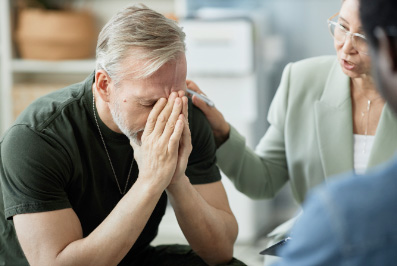Time Does NOT Heal
A strict definition of P.T.S.D. might refer to experiences involving wartime or deadly danger.
This condition manifests in a group of symptoms and feeling, including problems such as:
- Intrusive symptoms
- Nightmares
- Spontaneous memories of the experience
- Flashbacks
- Avoidant behaviors
- Emotional numbing
- Detachment/withdrawal from ordinary life
- Avoiding anxiety stimulating situations or people
- Arousal symptoms
- Hypervigilance
- Anger outbursts
- Exaggerated “startle response”
A far more common and minor version of this disorder is part of universal human experience of traumatic stress. The stressful event may not have been connected, for example, with the fear of losing your life, nevertheless, the recipient has a toxic memory experience “frozen” into the nervous-emotional system in some way. The memory reliably brings great emotional distress far into the future. It is not changed much over time.
More obviously we suffer because of the defined event. this can be an accident, an assault or an experience where we became fearful and helpless. Sometimes it is an accumulation of stressful experiences over time in some occupations.
In childhood, the experience of hurt and fear in “normal” development can cause emotions to be suppressed, and stunt emotional development. this is the central idea behind psychotherapist Alice Miller’s book, “the Drama Of Being A Child”. To this extent we all have “traumatic” memories and experience worth addressing and treating if they do under problems in or present—often outside our awareness.
Even more importantly, we now know that the soldiers who suffered the most following war service in Vietnam tended to have the most suffering before they went to Vietnam—when they were young, often in their family of origin. In that conflict, soldiers were not able to process all that happened to them before they were flown back home, whereas in World War 2, many soldiers had a long period of time after the battles to travel home and talk with their buddies. Even so, the graphic film, “Saving Private Ryan”, set in World War 2, screened in American cinemas “full of weeping older men” according to newspaper reports. [reference Professor Sandy McFarlane (Head of the Department of Psychiatry, University of Adelaide). article in the “Australian Doctor” 12 May 1998.
There is a universal pattern of response to intense fear. the consistency of reaction validates P.T.S.D. following such fear.
Other abnormal reactions to trauma exposure include:
- Dissociation (a feeling of being “split off” for what is happening
- Somatisation (the body has problems and poor function)
- Affect deregulation (lack of emotional self-regulation leading to problems), These include:
- Difficulty to mediating anger (outbursts)
- Self-destructive/suicidal behavior
- Risk-taking behavior
- Depression (up to 50 percent of sufferers
- Anxiety disorders (e.g. panic excessive fears, agitation)
This means sufferers lose contact in their inner world with what keeps them steady and secure, and feel the loss of that previous way of being. As time passes, the person can also begin to blame themselves for not getting better more quickly, or even for developing the personal reaction problem in the first place.
Where someone you care for has been harmed, it is important to recognize co-existing “grief” for friends and relatives in these disorders—others become disturbed by the trauma indirectly, since the horror of the experience can disturb the
“object-relatednesss” with the image of the loved one (the way we think and feel about them).
There is an accumulated risk from repeated exposure to traumatic events, as in emergency work, and this can be triggered sometimes by a single event which is a particularly “meaningful” or upsetting one to the individual. Sometimes it is unpredictable —our capacity to cope with bad things is very individual. The classic example is war, often severe emotional trauma is a daily event. The role of the media in traumatizing—and re-traumatizing viewers—using repeats of the the nightly news should not be underestimated. Now depictions of real and graphic violence are brought into homes so easily. Many people and children became very afraid after ‘September 11’ according to my information, when they had no personal reason to be scared.
Psychiatrist Anthony Feinstein from the University of Toronto contacted 140 war journalists in 2000 and interviewed one in five, he found the 27% had symptoms of P.T.S.D. (source The Walkley Magazine).
The biology of P.T.S.D. is not the biology of stress—it is much more. There is disruption of the person’s capacity to modulate stimulation (“self-soothe”), and to memory systems. We don’t tend to settle down after the danger passes. Traumatic experiences can the toxic to the brain because of direct neurohormonal influences coupled with progressive increase in the “sensitivity” of parts of the brain. This is thought to be particularly marked in children subjected to chronic abuse.
After trauma: “There is a critical transition phase, within the first few days, where the effects of trauma don’t subside for some; they start to become chronic. There is a progressive escalation of symptoms rather than coping…(quote from reference article).
